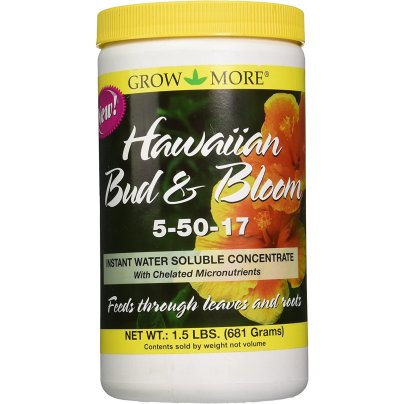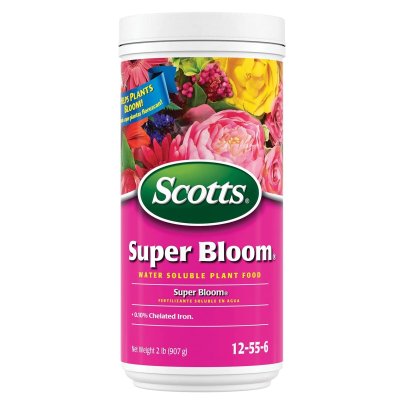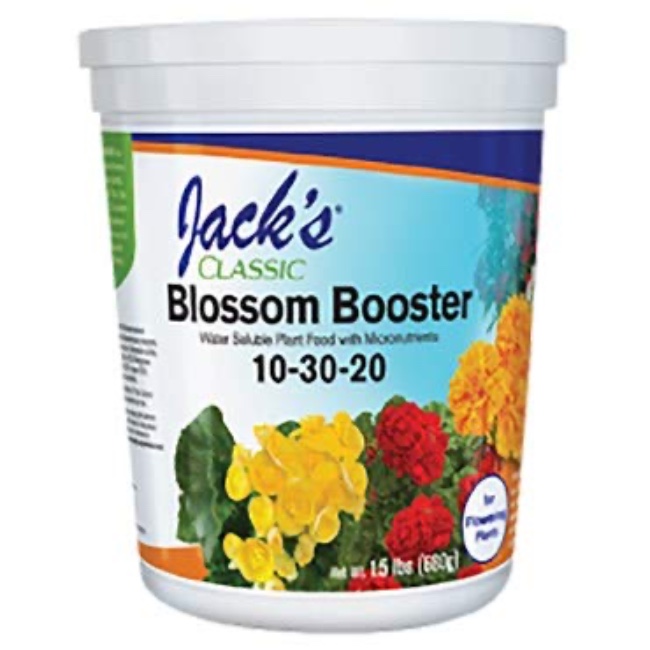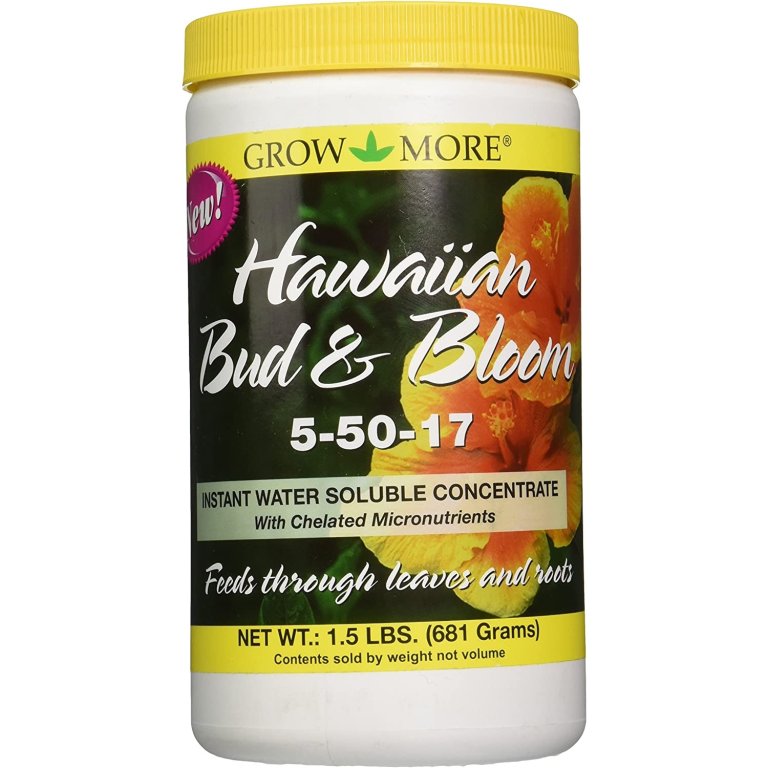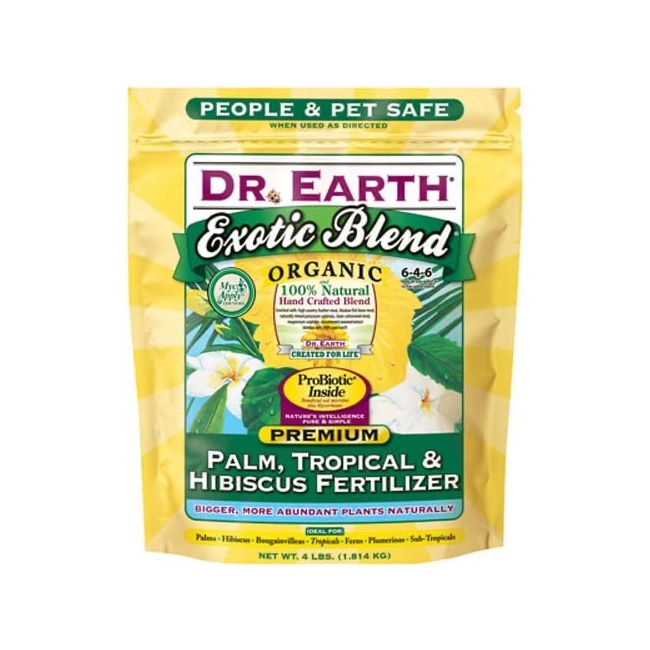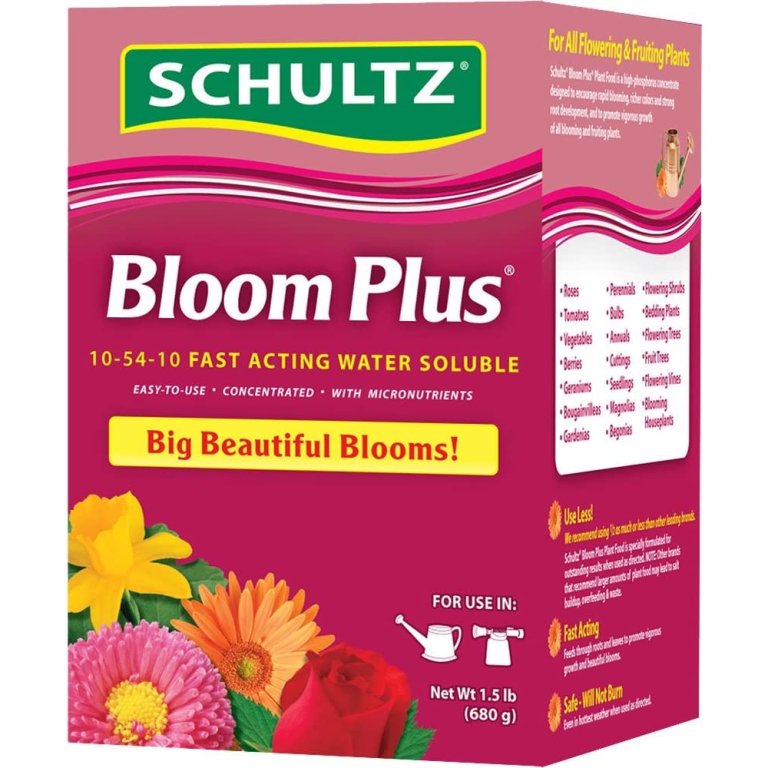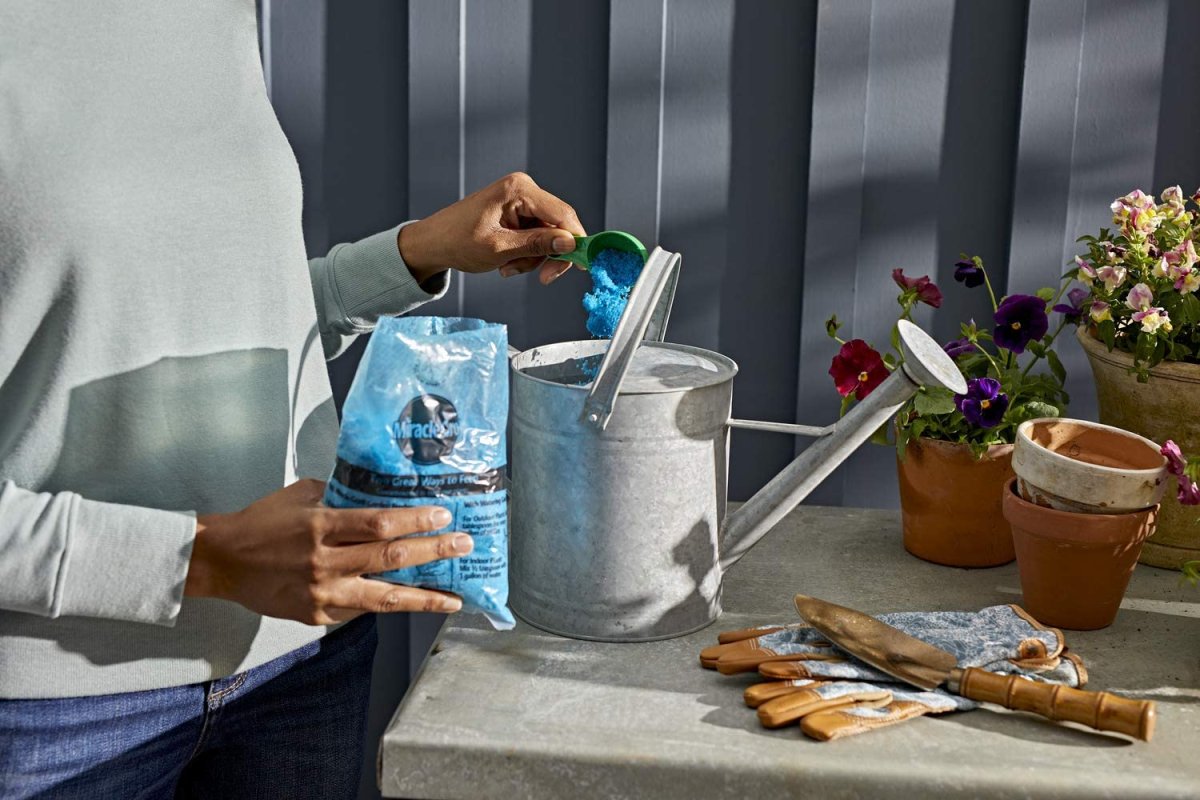
We may earn revenue from the products available on this page and participate in affiliate programs. Learn More ›
Plumerias, also called frangipani, are small tropical trees. They’re native to tropical America but are popular worldwide. Although they thrive in USDA 10b to 11 hardiness zones, they can grow in most climates with proper gardening care. To ensure plant health outside their native-type habitat, growers can keep their plumeria plants in pots, bring them inside during the winter, and provide optimal nutrients with plumeria plant food fertilizer.
Plumerias need a fertilizer high in phosphorus and low in nitrogen, which encourages blooming plumeria growth while preventing the plant from developing more foliage than flowers. Our top pick, Jack’s Classic Blossom Booster, provides plants with a 1:3:2 nutrient ratio to encourage flower growth and boost plumeria bloom vibrancy.
Here’s a look at some of the best fertilizers for plumeria.
- BEST OVERALL: J.R. Peters Jack’s Classic Blossom Booster
- RUNNER-UP: Grow More Hawaiian Bud and Bloom
- BEST BANG FOR THE BUCK: Scotts Super Bloom Water Soluble Plant Food
- BEST GRANULAR: Nelson Plant Food NutriStar Plumeria Food
- BEST ORGANIC: Dr. Earth Organic and Natural Exotic Blend
- BEST MULTIUSE: Miracle-Gro Water Soluble Bloom Booster Flower Food
- HONORABLE MENTION: Schultz Bloom Plus Plant Food
- ALSO CONSIDER: Element Nutrients Flower Fuel Bloom Booster
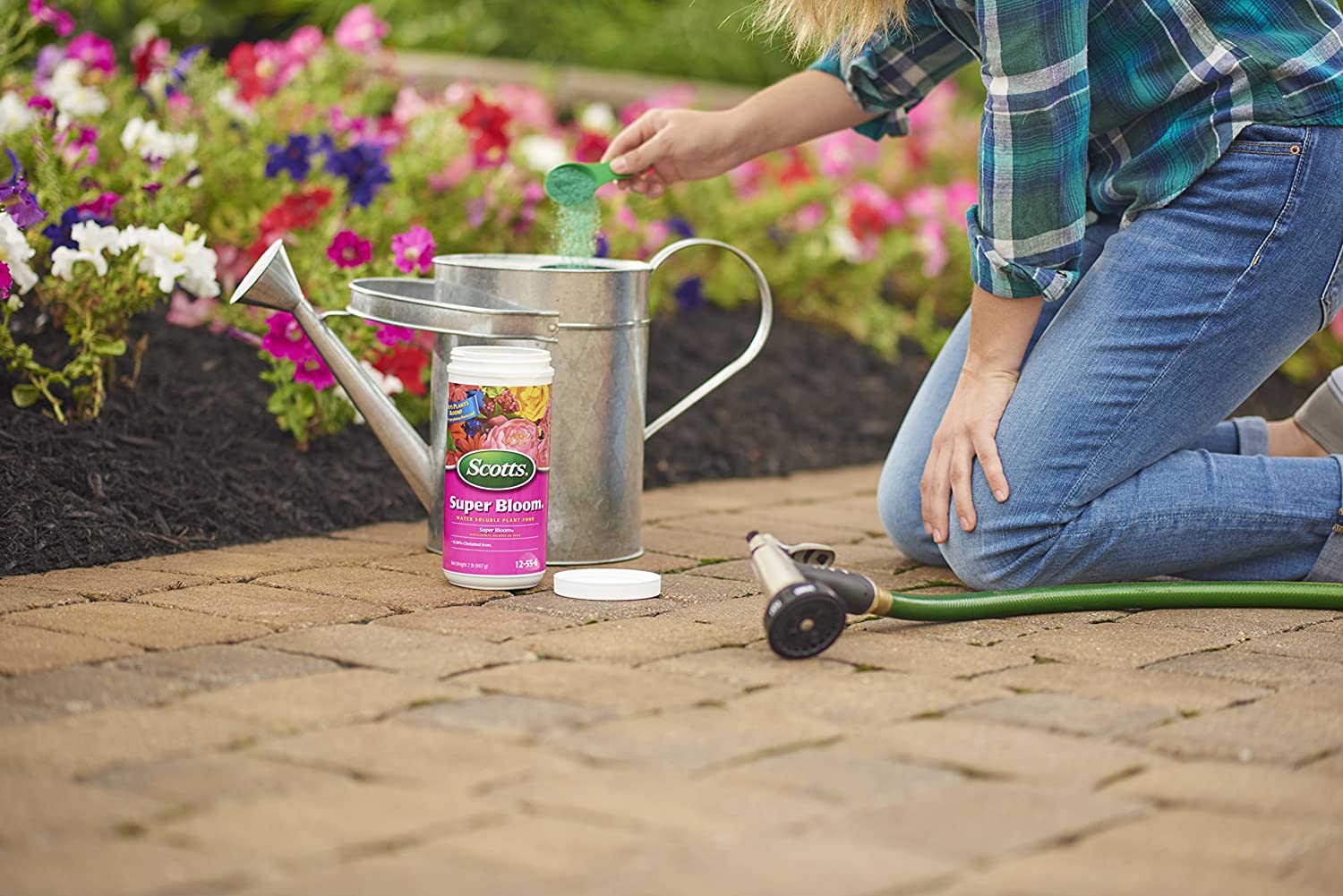
| Type | NPK Ratio | Organic/Inorganic | |
| J.R. Peters Jack’s Classic Blossom Booster | Water-soluble powder | 10-30-20 | Not specified |
| Grow More Hawaiian Bud and Bloom | Water-soluble | 5-50-17 | Not specified |
| Scotts Super Bloom Water Soluble Plant Food | Water-soluble | 12-55-6 | Inorganic |
| Nelson Plant Food NutriStar Plumeria Food | Granular | 5-30-5 | Inorganic |
| Dr. Earth Organic and Natural Exotic Blend | Dried organic matter | 5-4-6 | Organic |
| Miracle-Gro Water Soluble Bloom Booster Flower Food | Water-soluble | 15-30-15 | Inorganic |
| Schultz Bloom Plus Plant Food | Water-soluble | 10-54-10 | Inorganic |
| Element Nutrients Flower Fuel Bloom Booster | Water-soluble | 1-34-32 | Inorganic |
Our Top Picks
When shopping for the best fertilizer for plumeria, consider one of the options in this list, which includes both organic and inorganic choices in a range of nutrient ratios to suit many plumeria-growing needs.
Best Overall
J.R. Peters Jack’s Classic Blossom Booster
What We Like
- 1:3:2 ratio promotes healthy plants and bold blooms
- A little goes a long way
- Use every 1 to 2 weeks
- Contains macronutrients and micronutrients
What We Don’t Like
- Highly concentrated formula can lead to accidental overuse
Product Specs
- Type: Water-soluble powder
- NPK ratio: 10-30-20
- Organic/Inorganic: Not specified
The 10-30-20 NPK ratio in Jack’s Classic Blossom Booster promotes large, vibrant flowers. In addition to the macronutrients it provides, it also contains seven essential micronutrients, which support plant and soil health.
Jack’s Classic Blossom Booster is a highly concentrated water-soluble powder. For outdoor plumeria plants, add 1 tablespoon of fertilizer to 1 gallon of water and use it every 7 to 14 days. This fertilizer is also suitable for other flowering plants. Since this product is so concentrated, users must take care not to overuse it. Too much fertilizer can cause a plumeria plant’s leaves to turn brown or yellow or even wilt.
Get the J.R. Peters fertilizer for plumeria on Amazon or Greenhouse Megastore (for 4 pounds).
Runner-Up
Grow More Hawaiian Bud and Bloom
What We Like
- Elevated phosphorus levels
- Use as foliar spray or soil drench
- Contains macronutrients and micronutrients
What We Don’t Like
- Directions don’t specify usage frequency
Product Specs
- Type: Water-soluble
- NPK ratio: 5-50-17
- Organic/Inorganic: Not specified
With an NPK of 5-50-17, Hawaiian Bud and Bloom has a high phosphorus-to-nitrogen ratio content. It’s ideal for tropical plants, including plumeria, but it can also promote growth in flowering plants, such as hydrangeas, mums, and impatiens.
This fertilizer comes in a water-soluble powder that can be used as a foliar spray or soil drench. To use Hawaiian Bud and Bloom as a foliar spray, dissolve 1 teaspoon in a gallon of water and spray it on dry plumeria leaves. To use it as a soil drench, dissolve 1 tablespoon in a gallon of water and apply it to the soil.
While this fertilizer can help bloom growth, it doesn’t specify how often to use it or when to fertilize plumeria, which can lead to overfertilization. To err on the side of caution, don’t use Hawaiian Bud and Bloom more than once every 1 to 2 weeks.
Get the Grow More fertilizer for plumeria on Amazon.
Best Bang for the Buck
Scotts Super Bloom Water Soluble Plant Food
What We Like
- High phosphorus levels for bloom growth
- Affordable
- Easy to mix
- Use only every 1 to 2 weeks
- Safe for all flowering plants and fruit trees
What We Don’t Like
- Contains only 1 micronutrient
Product Specs
- Type: Water-soluble
- NPK ratio: 12-55-6
- Organic/Inorganic: Inorganic
Scotts Super Bloom has an NPK ratio of 12-55-6 to support bloom growth. It’s an easy-to-use and affordable plumeria plant food. While growers can use this fertilizer on all flowering plants and fruit trees, the high phosphorus content makes it especially ideal for boosting plumeria blooms.
To use this product, dissolve 1 tablespoon of the powder in 1 gallon of water. Next, water plumeria around its base. Growers can use Scotts Super Bloom every 1 to 2 weeks.
While this fertilizer helps plumeria grow bright flowers, it contains only one micronutrient, which is fewer than comparable products. Also, like other synthetic water-soluble options, Scotts Super Bloom is concentrated, so be careful not to overuse it.
Get the Scotts fertilizer for plumeria on Amazon or at Lowe’s.
Best Granular
Nelson Plant Food NutriStar Plumeria Food
What We Like
- Easy-to-use granular pellets
- Slow-release nitrogen keeps plants healthy without causing foliage overgrowth
- Contains micronutrients, including sulfur
- Effective for all flowering tropical plants
What We Don’t Like
- Synthetic ingredients
Product Specs
- Type: Granular
- NPK ratio: 5-30-5
- Organic/Inorganic: Inorganic
Granular fertilizers for plumeria seem to be less common than they are for other houseplants or trees. This fertilizer from Nelson packs an NPK ratio of 5-30-5 in convenient granular pellets. It contains five types of nitrogen to feed plumeria plants and a high level of phosphorus to encourage bloom growth. This fertilizer also contains micronutrients, including sulfur, which can bring the soil to the proper acidity.
To fertilize plumeria plants, add the specified amount based on the plumeria’s container size. For example, for a plumeria in a 1-gallon pot, add 2 teaspoons to the soil every 1 to 2 weeks. Water the plant after application.
Get the Nelson Plant Food fertilizer for plumeria on Amazon.
Best Organic
Dr. Earth Organic and Natural Exotic Blend
What We Like
- Organic and GMO-free
- Use only every 2 months
- Works for plumeria, palm, hibiscus, and other tropical plants
What We Don’t Like
- Low phosphorus levels
- May be better suited for young plants
Product Specs
- Type: Dried organic matter
- NPK ratio: 5-4-6
- Organic/Inorganic: Organic
For gardeners who prefer organic fertilizer, Dr. Earth Organic and Natural Exotic Blend contains an NPK ratio of 5-4-6 and is safe to use on palm, tropical, and hibiscus plants.
For an outdoor container-grown plumeria, add 2 tablespoons of fertilizer for every 6 inches of pot diameter. Work it into the soil and water afterward. Apply this product every 2 months.
While all-natural ingredients are great, this fertilizer contains minimal phosphorus, not ideal for gardeners looking to encourage big blooms on an established plant.
Get the Dr. Earth fertilizer for plumeria on Amazon.
Best Multiuse
Miracle-Gro Water Soluble Bloom Booster Flower Food
What We Like
- Suitable for all flowering plants
- Inexpensive and long-lasting
- Works with Miracle-Gro Garden Feeder, allowing fertilization with a garden hose
What We Don’t Like
- Higher nitrogen ratio
Product Specs
- Type: Water-soluble
- NPK ratio: 15-30-15
- Organic/Inorganic: Inorganic
This Miracle-Gro Bloom Booster Flower Food has an NPK ratio of 15-30-15. It promotes bloom growth while providing nutrition to keep the rest of the plant healthy.
This plant food for plumeria comes in an easy-to-mix water-soluble powder. Add 1 tablespoon of fertilizer to 1 gallon of water for outdoor plumeria. Gardeners can use Miracle-Gro Bloom Booster with the Miracle-Gro Garden Feeder or a watering can.
However, this product has a higher nitrogen ratio than the other options on this list. Nitrogen encourages trunk and foliage growth, a less-than-preferable outcome for potted plumeria plants.
Get the Miracle-Gro fertilizer for plumeria at Ace Hardware (for 1 pound), The Home Depot, or Lowe’s.
Honourable Mention
Schultz Bloom Plus Plant Food
What We Like
- Promotes big colorful blooms
- Works on all flowering plants
- Optimizes plant health by releasing macronutrients and micronutrients
What We Don’t Like
- Can lead to plant burns if not used as directed
Product Specs
- Type: Water-soluble
- NPK ratio: 10-54-10
- Organic/Inorganic: Inorganic
Schultz Bloom Plus Plant Food has an NPK ratio of 10-54-10, making it an ideal fertilizer for most flowering plants. Growers can use it to boost plumeria blooms, but it also works well on bedding plants, houseplants, roses, and vegetables.
When ready to fertilize, add the specified amount to a watering can or garden feeder-hose attachment and water around the base of the plant. The fertilizer will continue to work every time it rains or when the plumeria receives water. Schultz Bloom Plus is highly concentrated, so be careful not to overuse it, which can lead to a burnt plumeria plant.
Get the Schultz fertilizer for plumeria on Amazon.
Also Consider
Element Nutrients Flower Fuel Bloom Booster
What We Like
- Nutrient blend encourages maximum absorption and bigger blooms
- Contains trace minerals
- Extremely concentrated; requires only ¼ teaspoon per gallon of water
What We Don’t Like
- Unclear usage instructions for flowering plants
Product Specs
- Type: Water-soluble
- NPK ratio: 1-34-32
- Organic/Inorganic: Inorganic
Element Nutrients Flower Fuel Bloom Booster contains a high percentage of phosphorus compared to nitrogen, which promotes large blooms that won’t get crowded by overgrown foliage. This fertilizer also contains trace minerals to optimize plant health.
Use Flower Fuel by mixing ¼ teaspoon of fertilizer with 1 gallon of water and watering plumeria plants with the mixture. The manufacturer suggests using this fertilizer with a base nutrient.
However, the usage instructions for Flower Fuel aren’t clear for flowering plants. And secondly, it’s the most concentrated fertilizer covered here, making it the most susceptible to overuse.
Get the Element Nutrients fertilizer for plumeria on Amazon.
Jump to Our Top Picks
How We Chose the Best Fertilizers for Plumerias
Plumerias are small tropical trees that grow well in zones 10b through 11, but since most gardeners live outside of this hardiness zone, plumeria is often grown in pots and brought indoors for the winter. We looked for fertilizers with high phosphorus levels and lower nitrogen levels, which is a balance of nutrients that promotes blooming plumeria, not its foliage. It also keeps plumerias from growing too large for their containers.
Once we found the best fertilizer for plumeria plants with the proper nutrient ratios, we checked for micronutrients, user reviews, ease of product use, and price. Finally, we looked for the best fertilizer for plumeria plants in several categories.
What to Consider When Choosing the Best Fertilizer for Plumerias
An effective plumeria fertilizer contains the proper nutrient balance. Since plumeria plants require a high amount of phosphorus, an all-purpose fertilizer with equal amounts of nitrogen, phosphorus, and potassium won’t cut it. In addition to considering nutrient balance when learning how to fertilize plumeria and choosing a plant food for plumeria, plumeria growers also must decide among the different forms of fertilizer and whether to choose a synthetic or an organic product.
Type
The three main types of fertilizer for plumerias are granular, water-soluble, and foliar spray. Any type of fertilizer is acceptable as long as it contains the proper nutrients.
- Granular: Granular fertilizer comes in hard pellets in a variety of shapes, often oblong or round. Granular fertilizer goes into the soil surrounding the plant. The granules may be “quick release” or “slow release,” which indicates the speed with which they deliver nutrients to the soil.
- Liquid or water-soluble: Most water-soluble fertilizers come in a concentrated powder. After dissolving the powder in water, the user adds it around the plant’s root system. Liquid fertilizers come in a concentrated or ready-to-use form.
- Foliar spray: Foliar spray goes directly onto a plant’s foliage, which then absorbs the nutrients. Many gardeners choose this type of fertilizer when a plant is deficient in a specific nutrient.
NPK Ratio
Like humans, plants need the proper nutrients to thrive. Most fertilizers contain three macronutrients—nitrogen (N), phosphorus (P), and potassium (K)—and a range of micronutrients.
On fertilizer packages, macronutrients are listed as “N-P-K” ratios, and a number value is assigned to denote the percentage of each in the package. For example, a fertilizer package labeled 10-30-15 means it contains 10 percent nitrogen, 30 percent phosphorus, and 15 percent potassium.
Because it promotes bloom growth, phosphorus is key for plumeria, more so than nitrogen; however, nitrogen is also necessary as it promotes trunk and foliage growth. Potassium helps water movement and overall health. For container-grown plumeria, too much nitrogen can cause the plant to outgrow its container and the foliage to overshadow the blooms.
Organic vs. Inorganic
Organic and inorganic fertilizers deliver the same or similar nutrients as their chemical counterparts. The main difference is their ingredients.
Inorganic fertilizer contains synthetic or man-made ingredients, which often are derived from minerals in nature and mixed with gasses or chemicals to create highly concentrated formulas. For example, to create organic phosphorus, fertilizer manufacturers extract it from phosphate rock and treat it with sulfuric acid.
Inorganic plumeria fertilizers are inexpensive, easy to use, and fast acting. However, since they’re so concentrated, it’s easy to use too much, which can burn the plant.
Organic fertilizers contain natural ingredients, often derived from rock, plant, and animal minerals. The most significant advantage of these products is that they usually contain trace microorganisms, which can help improve soil quality. Most are also nontoxic and safe for kids and pets. The biggest di
FAQs
Plumeria plants require adequate sunlight, water, and fertilization. Growers can propagate cuttings of this tropical plant with a rooting hormone and keep them thriving by bringing them indoors during cold weather. Unfortunately, plumeria plants are also susceptible to whitefly infestations, which can be challenging to eliminate if not dealt with promptly. Let’s look at some other common questions about plumeria and issues with growing it.
Q. How do I get my plumeria to flower?
To flower, plumeria needs at least 6 hours of sunlight per day. If it receives optimal sunlight, encourage bloom growth with a fertilizer high in phosphorus.
Q. Can plumeria get too much sun?
Too much direct sunlight can burn plumeria plants. Move plumeria out of direct sunlight if the leaves are yellow or have scorched brown spots.
Q. How often should I water my plumeria?
Since plumeria needs to dry in between waterings, frequency depends on climate. Water once per week or when the plumeria’s soil is dry to the touch.
Q. Can I fertilize my plumeria when the soil is dry?
There is typically no need to water a plumeria before fertilization unless the soil is bone dry. Instead, follow the directions on a fertilizer package to learn how to fertilize plumeria properly.
Q. Do plumeria like coffee grounds?
Plumeria plants prefer slightly acidic soil. If the soil is pH neutral, adding coffee grounds may increase acidity levels, which can be beneficial.

